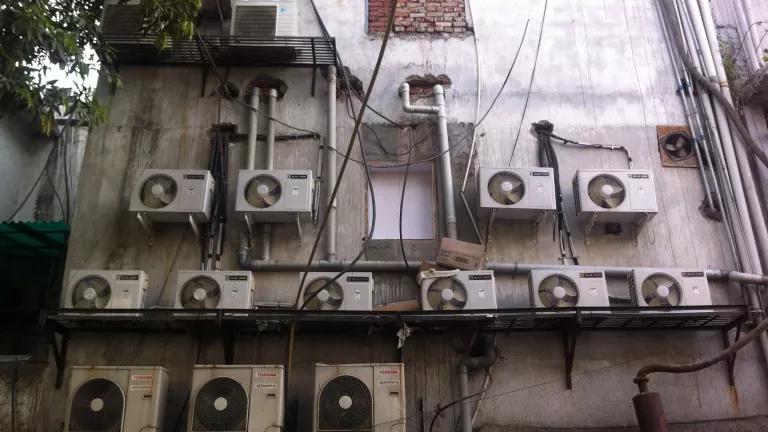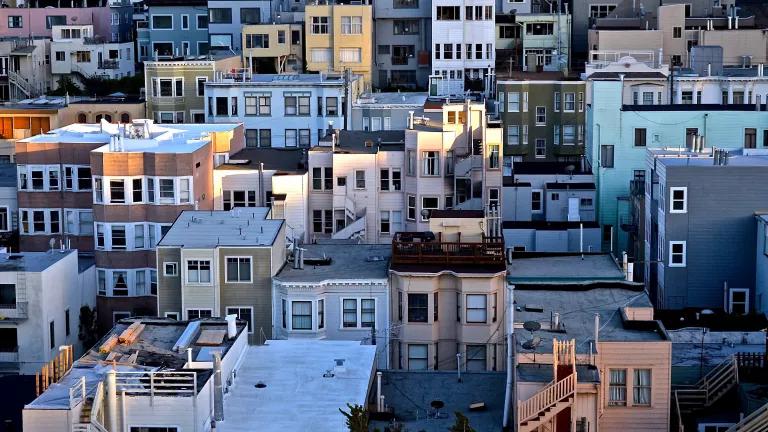Hyderabad Announces Cool Roofs Initiative with Experts

Co-authored with Nehmat Kaur and Sameer Kwatra
The city of Hyderabad is bracing for a very hot summer in 2017. According to the Indian Meteorological Department, the 2017 summer in Hyderabad is expected to be even warmer than 2016—the hottest year in recorded history. NRDC, in partnership with the Administrative Staff College of India (ASCI) and the Indian Institute of Public Health, Gandhinagar (IIPHG) is doing something to protect the public from the dangers of extreme heat: deploying cool roofs.
I am writing this blog in this beautiful city in South India, where I am working with colleagues and partners from Hyderabad, Delhi, and Washington, D.C. We are almost ready for lunch after putting the finishing touches on my presentation for this afternoon, and the temperature is already 35C/95F (!) headed for 36/97 under hot cloudless skies. This is the first day of spring; one can only imagine the heat stress that summer will bring (my last trip to India in early May 2016 I experienced a temperature of 46C/116F!).
Communities across India are facing deadly threats from high temperatures. In 2015, a devastating heat wave claimed more than 2,300 lives in India, with a majority of the deaths concentrated in the states of Telangana, Andhra Pradesh and Odisha. The risks increase each year due to global climate change. In addition, rapid urbanization in India’s booming cities is adding to the threat by creating a growing urban heat island effect, increasing the health risk to citizens across the country.
With more frequently occurring extreme temperatures, demand for air conditioning in India is surging, posing a considerable challenge for increasing energy use in the country. Those who can afford air conditioning must spend more on power, and this increased energy use also causes more air pollution for everyone. And the majority of Indians, who lack air conditioning, will suffer more discomfort and increased risk of sickness and death.
Leading cities in India are working with experts on solutions like cool roofs that provide affordable cooling comfort and are energy efficient. Telangana’s Department of Municipal Administration and Urban Development and the Greater Hyderabad Municipal Corporation met with NRDC and partners in Hyderabad this week on designing a cool roofs program for the city.
Cool roofs are white-colored roofs that reduce internal temperatures in buildings. They enhance comfort by reflecting sunlight away from the building. This minimizes heat absorption by the roof. Cool roofs also reduce temperatures by emitting more thermal radiation. This radiation helps to dissipate the solar heat gain and keep the building cooler. By bringing down temperatures inside a building, cool roofs also reduce the need for air conditioning, providing more affordable cooling for those who cannot afford appliances such as air conditioners. They also reduce the load on buildings that do have air conditioning.
Simple options such as lime-based white wash, tarp-like coverings or white ceramic tiles, that are low cost, can help bring roof temperatures down by as much as 30 degrees centigrade and reduce indoor temperatures by 3 to 5 degrees centigrade.
By dropping indoor temperatures for buildings, cool roofs offer multiple benefits for a city. They serve to protect vulnerable groups such as children and elderly from excessive indoor heat, and increase comfort levels for everyone during hot summer days.
Figure 1: Dark Roofs in Hyderabad March 2017
Figure 2: More Hyderabad Dark Roofs

[Note that both of these pictures were taken in the "near infrared". Nearly half of the heat in sunlight is near infrared, so the darkness or lightness in that part of the spectrum matters. It is possible to make roofing material that is visibly colored like red roof tile but is light and reflective in the infrared. See how trees that look dark in normal light look white or gray in these pictures: so when we replace vegetation with dark roofs, we increase heat retention.Notice also that the light-colored parts of the picture are walls, not roofs.]
Moreover, when implemented on a large scale, cool roofs can reduce the urban heat island effect, where heat absorption by dark roofs and pavement raise the temperature of a whole city by a few degrees compared to the surrounding countryside where cropland and forests reflect sunlight. Reducing urban heat islands, one building at a time, benefits the entire city.
For air-conditioned buildings, cool roofs can reduce cooling demand thus saving money and energy. By reducing the demand for electricity, cool roofs offer opportunities to lower air pollution and greenhouse gas emissions, as well. And by reducing heat islands, we further reduce air pollution, because some types of pollution are produced by chemical reactions in the atmosphere, which are slowed down when air temperatures are lower.
Leading cities across the world are recognizing these benefits. The city of New York started a cool roofs program in 2009 that targets cool roof coverage of one million square feet every year. Led by the New York Department of Small Business Services, and supported by the New York City Mayor’s Office of Recovery and Resiliency, the program provides training and skills to applicants with the ultimate aim of providing full employment as an added benefit for the city.
In the state of California, the city of Burbank runs a Voluntary Residential Cool Roof Program, led by the Building Division of their Community Development Department. The program encourages citizens to install cool roofs, with a view to reduce home-owner energy use as well as mitigate urban heat island effect. As part of their voluntary program, the city of Burbank also piloted a “Residential Roof Permit Refund Program” which allows home-owners that install cool roofs to qualify for a refund on their roof permit fees, conditional on the reflectance value of the roofs.
In India, cities like Delhi and Mumbai have supported cool roofs as a way for the city to be cooler and more energy efficient. Moreover, cool roofs become particularly important for communities living in slums and low income housing that are extremely vulnerable to rising temperatures. This vulnerability is the consequence of many factors, including lack of access to fans, ice and health care.
In an effort to provide affordable cooling to urban poor, NRDC and its partners, the Indian Institute of Public Health—Gandhinagar (IIPH-G) and ASCI, are collaborating with the city and state government in Hyderabad to pilot cool roofs in low-income housing communities in the city. The cool roof pilot project aims to demonstrate cost-effective solutions to increase thermal comfort and provide health benefits. Another objective is to develop sustainable financing solutions in partnership with city officials and other key stakeholders to scale these solutions as well as link them to existing institutional frameworks such as India’s Smart Cities program.
Scaling such solutions is critical in the face of increasing cooling demand and increasing risk of heat-related health problems in cities across India. The building sector is a clear opportunity to address this with cost-efficient, smart and affordable solutions. Cool-roof programs work to decrease the demand for cooling and to provide enhanced comfort to those without access to air conditioning. They offer an opportunity to reduce electricity demand and generate energy savings that translate directly to financial savings. These actions together will build a smart, sustainable and affordable cooling future for cities in India.




